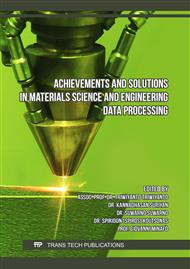[1]
I. Khan, C.S. Kamma-Lorger, S.D. Mohan, A. Mateus, G.R. Mitchell, The exploitation of polymer based nanocomposites for additive manufacturing: a prospective review, in: Applied Mechanics and Materials, Trans Tech Publ, 2019: p.113–145.
DOI: 10.4028/www.scientific.net/amm.890.113
Google Scholar
[2]
S.D. Mohan, M. Nazhipkyzy, P. Carreira, C. Santos, F.J. Davis, A. Mateus, G.R. Mitchell, Direct digital manufacturing of nanocomposites, in: Applied Mechanics and Materials, Trans Tech Publ, 2019: p.92–97.
DOI: 10.4028/www.scientific.net/amm.890.92
Google Scholar
[3]
R. Purohit, K. Purohit, S. Rana, R.S. Rana, V. Patel, Carbon nanotubes and their growth methods, Procedia Materials Science. 6 (2014) 716–728.
DOI: 10.1016/j.mspro.2014.07.088
Google Scholar
[4]
Z.-X. Wang, H.-S. Shen, Nonlinear vibration and bending of sandwich plates with nanotube-reinforced composite face sheets, Composites Part B: Engineering. 43 (2012) 411–421.
DOI: 10.1016/j.compositesb.2011.04.040
Google Scholar
[5]
P. Zhu, Z.X. Lei, K.M. Liew, Static and free vibration analyses of carbon nanotube-reinforced composite plates using finite element method with first order shear deformation plate theory, Composite Structures. 94 (2012) 1450–1460.
DOI: 10.1016/j.compstruct.2011.11.010
Google Scholar
[6]
B. Huang, Y. Guo, J. Wang, J. Du, Z. Qian, T. Ma, L. Yi, Bending and free vibration analyses of antisymmetrically laminated carbon nanotube-reinforced functionally graded plates, Journal of Composite Materials. 51 (2017) 3111–3125.
DOI: 10.1177/0021998316685165
Google Scholar
[7]
C.-L. Thanh, P. Phung-Van, C.H. Thai, H. Nguyen-Xuan, M.A. Wahab, Isogeometric analysis of functionally graded carbon nanotube reinforced composite nanoplates using modified couple stress theory, Composite Structures. 184 (2018) 633–649.
DOI: 10.1016/j.compstruct.2017.10.025
Google Scholar
[8]
R. Ansari, J. Torabi, M.F. Shojaei, Buckling and vibration analysis of embedded functionally graded carbon nanotube-reinforced composite annular sector plates under thermal loading, Composites Part B: Engineering. 109 (2017) 197–213.
DOI: 10.1016/j.compositesb.2016.10.050
Google Scholar
[9]
M.I. Ansari, A. Kumar, S. Fic, D. Barnat-Hunek, Flexural and free vibration analysis of CNT-reinforced functionally graded plate, Materials. 11 (2018) 2387.
DOI: 10.3390/ma11122387
Google Scholar
[10]
Y. Chiker, M. Bachene, M. Guemana, B. Attaf, S. Rechak, Free vibration analysis of multilayer functionally graded polymer nanocomposite plates reinforced with nonlinearly distributed carbon-based nanofillers using a layer-wise formulation model, Aerospace Science and Technology. 104 (2020) 105913.
DOI: 10.1016/j.ast.2020.105913
Google Scholar
[11]
A. Melaibari, A.A. Daikh, M. Basha, A. Wagih, R. Othman, K.H. Almitani, M.A. Hamed, A. Abdelrahman, M.A. Eltaher, A Dynamic Analysis of Randomly Oriented Functionally Graded Carbon Nanotubes/Fiber-Reinforced Composite Laminated Shells with Different Geometries, Mathematics. 10 (2022) 408.
DOI: 10.3390/math10030408
Google Scholar
[12]
A. Melaibari, A.A. Daikh, M. Basha, A.W. Abdalla, R. Othman, K.H. Almitani, M.A. Hamed, A. Abdelrahman, M.A. Eltaher, Free Vibration of FG-CNTRCs Nano-Plates/Shells with Temperature-Dependent Properties, Mathematics. 10 (2022) 583.
DOI: 10.3390/math10040583
Google Scholar
[13]
E.F. Crawley, J. De Luis, Use of piezoelectric actuators as elements of intelligent structures, AIAA Journal. 25 (1987) 1373–1385.
DOI: 10.2514/3.9792
Google Scholar
[14]
E.F. Crawley, K.B. Lazarus, Induced strain actuation of isotropic and anisotropic plates, AIAA Journal. 29 (1991) 944–951.
DOI: 10.2514/3.10684
Google Scholar
[15]
S.C. Her, C.Y. Liu, The deflection of a simply supported plate induced by piezoelectric actuators, Journal of Mechanical Science and Technology. 21 (2007) 1745.
DOI: 10.1007/bf03177404
Google Scholar
[16]
K.Y. Lam, X.Q. Peng, G.R. Liu, J.N. Reddy, A finite-element model for piezoelectric composite laminates, Smart Materials and Structures. 6 (1997) 583.
DOI: 10.1088/0964-1726/6/5/009
Google Scholar
[17]
A. Alibeigloo, Static analysis of functionally graded carbon nanotube-reinforced composite plate embedded in piezoelectric layers by using theory of elasticity, Composite Structures. 95 (2013) 612–622.
DOI: 10.1016/j.compstruct.2012.08.018
Google Scholar
[18]
S. Natarajan, M. Haboussi, G. Manickam, Application of higher-order structural theory to bending and free vibration analysis of sandwich plates with CNT reinforced composite facesheets, Composite Structures. 113 (2014) 197–207.
DOI: 10.1016/j.compstruct.2014.03.007
Google Scholar
[19]
D. Wu, L. Huang, B. Pan, Y. Wang, S. Wu, Experimental study and numerical simulation of active vibration control of a highly flexible beam using piezoelectric intelligent material, Aerospace Science and Technology. 37 (2014) 10–19.
DOI: 10.1016/j.ast.2014.04.008
Google Scholar
[20]
T. Huu Quoc, T. Minh Tu, V. Van Tham, Free vibration analysis of smart laminated functionally graded CNT reinforced composite plates via new four-variable refined plate theory, Materials. 12 (2019) 3675.
DOI: 10.3390/ma12223675
Google Scholar
[21]
A.M.K. Esawi, M.M. Farag, Carbon nanotube reinforced composites: potential and current challenges, Materials & Design. 28 (2007) 2394–2401.
DOI: 10.1016/j.matdes.2006.09.022
Google Scholar
[22]
J. Yang, Introduction To The Mathematical Theory Of Vibrations Of Elastic Plates, An-By RD Mindlin, World Scientific, (2006).
Google Scholar
[23]
J.N. Reddy, Mechanics of laminated composite plates and shells: theory and analysis, CRC press, (2003).
Google Scholar
[24]
H.F. Tiersten, Linear Piezoelectric Plate Vibrations. Plenum Press, New York (1969)., (n.d.).
Google Scholar
[25]
C.-K. Lee, Theory of laminated piezoelectric plates for the design of distributed sensors/actuators. Part I: Governing equations and reciprocal relationships, The Journal of the Acoustical Society of America. 87 (1990) 1144–1158.
DOI: 10.1121/1.398788
Google Scholar
[26]
H.S. Tzou, Piezoelectric shells, Springer, (1993).
Google Scholar
[27]
G. Dhatt, G. Touzot, E. Lefrançois, Méthode des éléments finis, Lavoisier, (2005).
Google Scholar
[28]
M. Ezzraimi, R. Tiberkak, A. Melbous, S. Rechak, LQR and PID algorithms for vibration control of piezoelectric composite plates, Mechanics. 24 (2018) 734–740.
DOI: 10.5755/j01.mech.24.5.20645
Google Scholar
[29]
G.R. Liu, K.Y. Dai, K.M. Lim, Static and vibration control of composite laminates integrated with piezoelectric sensors and actuators using the radial point interpolation method, Smart Materials and Structures. 13 (2004) 1438.
DOI: 10.1088/0964-1726/13/6/015
Google Scholar
[30]
P. Phung-Van, T. Nguyen-Thoi, T. Le-Dinh, H. Nguyen-Xuan, Static and free vibration analyses and dynamic control of composite plates integrated with piezoelectric sensors and actuators by the cell-based smoothed discrete shear gap method (CS-FEM-DSG3), Smart Materials and Structures. 22 (2013) 95026.
DOI: 10.1088/0964-1726/22/9/095026
Google Scholar
[31]
P. Phung-Van, L. De Lorenzis, C.H. Thai, M. Abdel-Wahab, H. Nguyen-Xuan, Analysis of laminated composite plates integrated with piezoelectric sensors and actuators using higher-order shear deformation theory and isogeometric finite elements, Computational Materials Science. 96 (2015) 495–505.
DOI: 10.1016/j.commatsci.2014.04.068
Google Scholar


